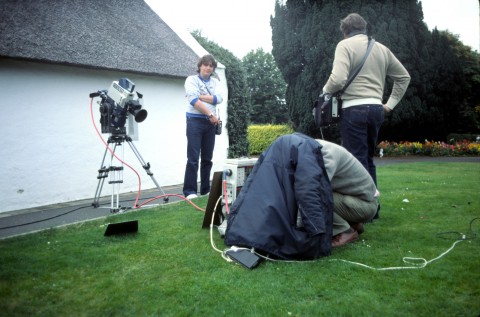Specially shot interview with costume designer Janice Rider, talking about sourcing clothes for television presenters. Janice mentions the challenges of finding a suitable outdoor jacket for wildlife cameraman and presenter, Simon King.
Monthly Archives: January 2012
Nagra – photos by Ian Collins
Photos by Ian Collins, no reproduction without permission.
Video editor Ian Collins took photos of various pieces of post-production technical kit before the fixtures and fittings of Pebble Mill were sold off in auction in Autumn 2004.
These photos are of a Nagra audio recorder. They were used in the PSC (portable single camera) edit suites until the 1990s. They were very rugged and reliable.
Please add a comment if you can add information about how the Nagras were used.
The following comment was made by recordist Murray Clarke about location Nagras: ‘Of course the Nagra 3 and 4s were the standard sound recording machine for location recordists for many many years before DAT became more common. I bought my mono Nagra 3 in 1971 for a cost of around £3200. I took it up to Yorkshire for a couple of episodes of all Creatures Great and Small – and it rained solidly for a fortnight!!!. My ‘over-qualified’ boom op and assistant was Dave Baumber, then the Dubbing Mixer at the newly-built Pebble Mill studios.’
Christopher Hall adds the following information: ‘This is a Nagra T. T for twin capstan. They had a computer controlled synchroniser which could chase timecode from the VT machine in an edit suite at high speed. I went on a factory course for these in the late 1980s. We spent a whole day learning how to repair the motors, and when we asked how long they usually lasted for a discussion in French and German revealed that they didn’t know because none had stopped yet!’
Paul Vanezis: ‘I tracklayed 10 episodes of ‘Chalkface’ and 8 episodes of ‘Specials’ on a Nagra T…’
Peter Poole: ‘This must be the finest tape recorder ever made. I spent ages trying to get film unit to buy one for the transfer suite. It never happened. But after seeing the price I could see why!’
Pete Simpkin: ‘Totally agree with you Peter……I used one to great effect recording a nightingale for a Radio Birmingham programme in the 70s. The standard reporter’s Uher was not up to the job and the simple version Nagra gave level control, mixing of two mics AND ‘off tape’ monitoring!’
New Year Opt-Out – Peter Poole
BBC Birmingham Studio Centre, Broad Street -Philip Morgan
The BBC Birmingham Studio Centre was at 282 Broad Street if I recall correctly. When Pebble Mill opened it was left derelict until the 1980’s and then demolished along with the adjoining buildings to make way for the new night life developments along Broad Street. The building was not on the site of the Hyatt Hotel but somewhat further down towards Five Ways.
One Saturday morning during the demolition I went along and asked the foreman if I could take a look and grab a souvenir. Despite the precarious nature of the site (as it was already being obliterated) he cheerfully let me go in – without a hard hat or high-vis jacket either!
I went through the half-timbered glass doors from Broad Street and up the staircase. The whole place was damp and musty and I explored various rooms and areas including what I believe was the former main control room. I managed to salvage a battered little wooden box with two studio warning lights which had presumably been above an entrance to one of the technical areas. It was sad to see the building in such a sorry state. I certainly never expected I would make a similar visit to its successor in the dying days of Pebble Mill.
Philip Morgan
Brian Johnson adds the following comment on the Facebook page: ‘I worked in the TV control room at Broad Street (then called Switching Centre) at the time that BBC 2 was just starting colour transmissions. At that time the Sound Control Room was separate and on a different floor. The two were combined into the Communications Centre when it was all moved to Pebble Mill.’
- « Previous Page
- 1
- 2
- 3
- 4
- …
- 6
- Next Page »





